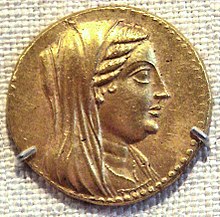Berenice II of Egypt
| Berenice II | |
|---|---|
| Queen of Egypt | |
 | |
| Born | c. 267 – 266 BC |
| Died | 221 BC |
| Spouse | Ptolemy III Euergetes |
| Issue | Ptolemy IV, Arsinoe III, Alexander, Magas, Berenice |
| Dynasty | Ptolemaic |
| Father | Magas of Cyrene |
| Mother | Apama II |

Berenice II (267 or 266 BC – 221 BC) was the daughter of Magas of Cyrene and Queen Apama II, and the wife of Ptolemy III Euergetes, the third ruler of the Ptolemaic dynasty of Egypt.
In about 249 BC, she was married to Demetrius the Fair, a Macedonian prince, soon after her father died. However, after coming to Cyrene he became the lover of her mother Apama. In a dramatic event, she had him killed in Apama's bedroom, but Apama lived on afterwards. She had no children with Demetrius.[1]
Afterwards she married Ptolemy III. Their children were: Ptolemy IV Philopator, Magas, Lysimachus, Alexander, Arsinoe III and Berenice.[2]
Berenice is said to have participated in the Nemean Games (between 245 and 241 BC) and to have competed in Olympic games at some unknown date.
Soon after her husband's death (221 BC) she was murdered at the instigation of her son Ptolemy IV, with whom she was probably associated in the government.[3]
Nevertheless, a decree “issued delineating the cult for the newly deified queen Berenike II…specified that men and women singers were to sing all day in front of the statue of Berenike.”[4]
Myths
During her husband's absence on an expedition to Syria, she dedicated her hair to Aphrodite for his safe return, and placed it in the temple of the goddess at Zephyrium. The hair having by some unknown means disappeared, Conon of Samos explained the phenomenon in courtly phrase, by saying that it had been carried to the heavens and placed among the stars. The name Coma Berenices or Berenice's hair, applied to a constellation, commemorates this incident. Callimachus celebrated the transformation in a poem, of which only a few lines remain, but there is a fine translation of it by Catullus.[3]
The city of Euesperides was refounded by her and received her name, Berenice (near the location of Benghazi). The asteroid 653 Berenike, discovered in 1907, is also named after Queen Berenice.[5]
References
- ^ Berenice II Archived February 25, 2015, at the Wayback Machine by Chris Bennett
- ^ Dodson, Aidan and Hilton, Dyan. The Complete Royal Families of Ancient Egypt. Thames & Hudson. 2004. ISBN 0-500-05128-3
- ^ a b One or more of the preceding sentences incorporates text from a publication now in the public domain: Chisholm, Hugh, ed. (1911). "Berenice". Encyclopædia Britannica. Vol. 3 (11th ed.). Cambridge University Press. p. 769.
- ^ See Elisabeth Meier Tetlow, Women, crime, and punishment in ancient law and society, Volume 2 (New York: Continuum International Publishing Group, 2005), 212.
- ^ Use of tree Oils. "Varnish and Berenice." Retrieved on September 02, 2010
External links
